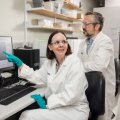In a scientific breakthrough set to benefit sufferers of respiratory diseases, a UQ research team has pioneered Australian first imaging technology.
A group of UQ scientists, from the Centre for Magnetic Resonance and the Department of Physics, have successfully developed Australia’s first hyperpolarised helium gas for use in human MRIs.
Dr Marlies Friese said the UQ team recently produced sufficient gas for a human subject to inhale, and created an image of the person’s airways.
Dr Friese said the team had previously done similar experiments using hyperpolarised helium imported from Germany.
“The gas is helium-3, it is inert, is not radioactive and does not react with the body so it is safe to inhale. This type of image is useful because we can obtain data on gas flow and breathing ¬– we are the first group in Australia to achieve this,” she said.
“It can show how gases flow in the lung, and whether regions of the lung are ventilated normally, abnormally or not at all.
“Now we are able to use our locally produced gas, the technology will become more accessible to local researchers and for research of diseases such as asthma and COPD.”
Dr Friese said when imaging the lung or other areas where the water content was low, conventional MRI had proved inadequate.
“Hyperpolarised helium MRI uses a special technique through which the nuclear magnetic moments of helium atoms are aligned so that MRI signals are enhanced by up to six orders of magnitude,” she said.
“The hyperpolarised effect is relatively short lived – it lasts up to 80 hours depending on how the gas is stored and transported, with the effectiveness decreasing during that time.”
Dr Friese said transport from overseas facilities was costly and difficult as transport delays can render the gas useless.
The gas was produced in the HP helium laboratory at UQ, which is the only one of its kind in Australia and was supported by a UQ internal infrastructure grant.
The lab was set-up through collaborations with Professor Brian Saam of the University of Utah.
The facility conducts respiratory research using animal models of disease, however interest from medical researchers recently directed the team’s efforts towards human imaging.
In the future, the method could potentially be used for diagnosis and monitoring of respiratory disease within a clinical setting.
The research is one of several collaborative projects including UQ, Brisbane’s Mater Children’s, Royal Children’s and Prince Charles Hospitals, the University of Utah, Victoria’s Alfred Hospital and Monash University, and the Johannes Gutenberg University.
Media: Dr Malies Friese (3346 9128, marlies.friese@cmr.uq.edu.au) or Eliza Plant at UQ Communications (07 3365 2619)
.jpg)



